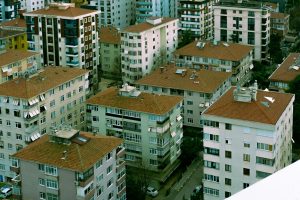The Evolution of Urban Density: From Sprawl to Vertical Living
When we think of cities, we often imagine sprawling neighborhoods filled with single-family homes and large open spaces. However, as the world’s population continues to grow, the need for more efficient use of urban space has become increasingly urgent. This has resulted in a shift towards vertical living, where buildings reach high into the sky and offer housing solutions for a larger number of people. This evolution of urban density, from sprawl to vertical living, has had a significant impact on the way we live and the future of cities. In this article, we will explore the history of urban density and how it has changed over time, leading us to the rise of vertical living.
The Beginning of Urban Density
The concept of urban density can be traced back to ancient civilizations, where cities were built to accommodate large populations in a small area. However, it wasn’t until the Industrial Revolution in the 19th century that urban density began to take on a more recognizable form. As people flocked to cities in search of job opportunities, the need for more efficient use of space became evident. This led to the development of taller buildings and the rise of apartment living.
The Era of Sprawl
As cities continued to grow in the 20th century, the focus shifted towards suburban living. The introduction of the automobile made it easier for people to live further away from the city center, resulting in the development of low-density neighborhoods and the sprawl of cities. This trend was fueled by the idea of the American Dream, where owning a single-family home with a yard was the ultimate goal.
However, this era of sprawl came at a cost. As cities spread out, they became less walkable and more reliant on cars, leading to increased traffic congestion and air pollution. The suburbs also caused a disconnect between people and their communities, as residents were often isolated from each other and had to travel long distances for basic needs.
The Rise of Vertical Living
In recent years, the need for more sustainable and efficient use of urban space has led to the rise of vertical living. With limited land resources in urban areas, the only way to accommodate a growing population is to build up. This has resulted in skyscrapers becoming a common sight in many cities around the world.
Benefits of Vertical Living
One of the main advantages of vertical living is that it allows for more people to be housed in a smaller area. This not only relieves the strain on land resources but also helps to promote a sense of community and interaction among residents. Vertical living also encourages walkability and the use of public transportation, reducing the dependence on cars and easing traffic congestion.
In addition to being more sustainable, vertical living offers a variety of housing options for people at different stages of their lives. From small apartments for young professionals to larger units for families, vertical living can cater to a diverse range of needs. This diversity also leads to a more diverse population and a vibrant mix of cultures and backgrounds.
The Future of Urban Density
As we continue to face growing urban populations and the need to reduce our environmental impact, the future of urban density will likely focus on a combination of vertical living and smart growth principles. Smart growth promotes the development of compact, walkable neighborhoods with a mix of land uses, creating a more livable and sustainable community.
Vertical living will also continue to evolve and become more efficient. With advances in technology and construction methods, buildings are becoming more environmentally friendly and energy-efficient, making vertical living even more sustainable for the future.
Challenges of Vertical Living
Despite its many benefits, vertical living also presents some challenges. One of the main concerns is the affordability of housing in high-density areas. As vertical living becomes more popular, the demand for these units increases, driving up the cost of living. This can lead to gentrification and displacement of low-income residents.
Another issue is the loss of green space in urban areas. As buildings reach higher and higher, the amount of green space available decreases, impacting the environment and the well-being of residents. It is crucial for city planners to consider the balance between development and the preservation of green areas.
Conclusion
The evolution of urban density from sprawl to vertical living is a reflection of the changing needs and priorities of our society. As we continue to face challenges in accommodating a growing population while also being mindful of our impact on the environment, it is clear that vertical living will play a significant role in the future of cities. With careful planning and consideration, it has the potential to create more sustainable and vibrant communities where people can thrive.










